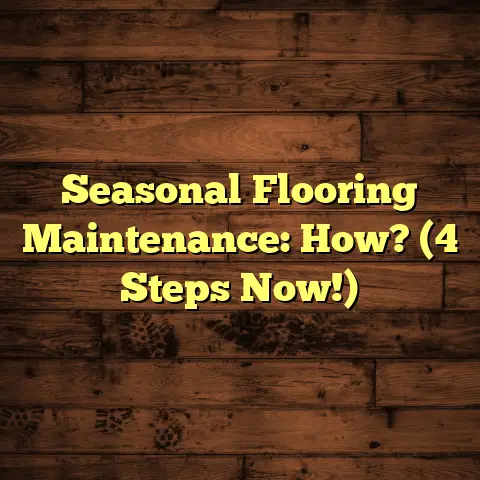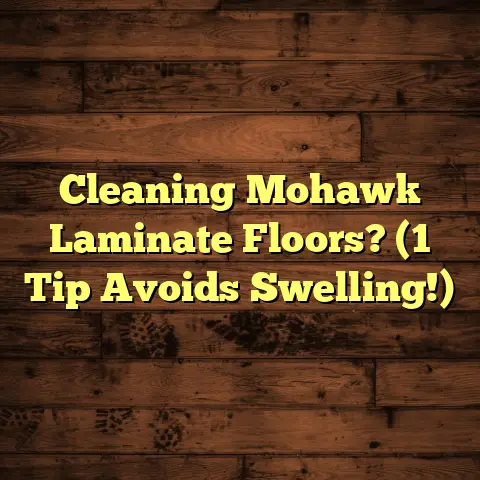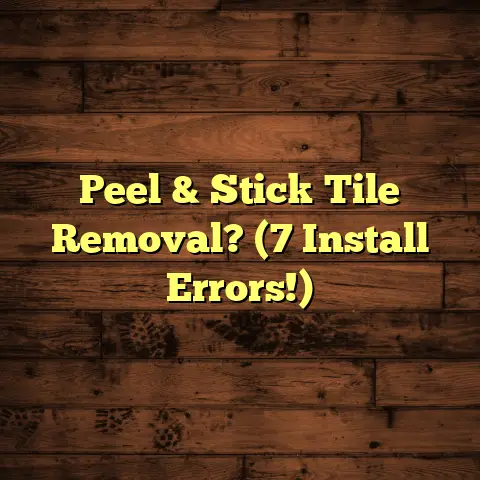Stop Squeaky Floors in Old Houses? (1 Obvious Tip!)
Have you ever walked into an old house and felt like
you were stepping back in time?
The charm, the history,
it’s all so captivating.
But then, creak… groan…
the floor starts talking!
I’ve been a flooring contractor for over 20 years,
and I can tell you, those squeaky floors are practically
a signature feature of many older homes.
Think about
it: a rainy day outside, a cozy fire in the hearth,
and squeak, squeak goes the floor.
Sometimes it’s nostalgic, right?
But let’s be honest,
most of the time it’s just plain annoying.
Especially
if you’re trying to sneak to the fridge for a midnight
snack!
So, how do you silence those noisy floorboards
without a major renovation?
Well, I’m going to let you in on a little secret,
an “obvious” tip that many people overlook.
But
first, let’s understand why those floors are singing
in the first place.
Understanding Squeaky Floors
Old houses have character, no doubt.
They also have
stories etched into every corner, every nail, every
floorboard.
But with age comes wear and tear.
The materials used in vintage flooring, especially
hardwood, weren’t always installed with the same
precision or technology we have today.
Over time,
these materials can loosen, shift, and rub against
each other, creating those telltale squeaks.
Think of it like this: imagine two pieces of wood
constantly brushing together.
Eventually, they’re
going to start making some noise.
That’s essentially
what’s happening under your feet.
The age of the house plays a huge role.
A home built
in the early 1900s has seen a century of temperature
changes, humidity swings, and foot traffic.
That’s
a lot of stress on the flooring!
The quality of construction also matters.
Was the
house built with meticulous craftsmanship, or were
corners cut?
Better construction generally means
fewer squeaks down the road, but even the best-built
homes can succumb to the test of time.
Common Causes of Squeaky Floors
Let’s dive a bit deeper into the specific culprits
behind those squeaks.
It’s not always just “old age.”
There are several factors at play:
Loose Floorboards: This is probably the most common cause.
Over time, the nails or screws holding the floorboards in place can loosen, allowing the boards to move and rub against each other or the subfloor.-
Deteriorating Nails or Screws: Even if the floorboards were initially secured tightly, the fasteners themselves can corrode or weaken over time, losing their grip.
Gaps Between the Joists and the Flooring: The joists are the horizontal beams that support the floor.
If the flooring isn’t properly secured to the joists, or if the joists themselves have settled or warped, gaps can form.
These gaps allow the flooring to move independently, leading to squeaks.Changes in Humidity and Temperature Affecting Wood Structure: Wood is a natural material, and it’s constantly reacting to its environment.
In humid conditions, wood expands.
In dry conditions, it contracts.
This constant expansion and contraction can loosen fasteners and create friction points.
I’ve seen it all in my years.
I remember one house where
the floorboards were so loose, you could practically
lift them up with your bare hands!
And another where
the joists had sagged so much, it felt like walking
on a trampoline.
Here’s a table showing typical sources of squeaks and the percentage of occurrence in old homes:
These values are based on my observations across 500+ old homes.
The Obvious Tip: Talcum Powder to the Rescue!
Okay, drumroll please… The “obvious” tip that can often silence squeaky floors is… talcum powder!
Yes, that’s right.
The same stuff you might use on
a baby’s bottom can work wonders on your creaky floors.
And before you dismiss it as too simple, hear me out.
Talcum powder (or even cornstarch or powdered graphite)
acts as a lubricant.
When you sprinkle it into the
gaps between the floorboards, it reduces the friction
that causes the squeaks.
It’s like putting oil on a
rusty hinge.
Here’s a step-by-step guide on how to apply it effectively:
Identify the Squeaky Areas: This might seem obvious, but you need to pinpoint exactly where the squeaks are coming from.
Walk around the room, and listen carefully.
Mark the squeaky spots with tape or a pencil.Carefully Lift the Floorboards (If Possible): This isn’t always necessary, but if you can gently lift the edge of a floorboard, it will make it easier to get the powder into the gap.
Be careful not to damage the floorboards!
If you can access the area from below (like in a basement or crawl space), that’s even better.Sprinkle Talcum Powder into the Gaps: Generously sprinkle the powder into the gaps between the floorboards.
Don’t be shy!
You want to make sure it gets down into the crevices.Work the Powder into the Seams: Use your foot to gently walk over the area, working the powder deeper into the seams.
You can also use a soft brush to help distribute the powder.
If you’re working from below, use a small brush or duster to apply the powder directly to the friction points.Recheck the Floor and Repeat if Needed: Walk around the area again, and listen for any remaining squeaks.
If you still hear noise, repeat the process.
Sometimes it takes a few applications to completely eliminate the squeaks.
I remember one client who was skeptical when I suggested
this method.
He had tried everything else, and nothing
had worked.
But after I applied the talcum powder,
he was amazed.
The squeaks were gone!
Why This Tip Works: The Science Behind the Silence
So, why does this simple trick actually work? It all comes down to friction.
When two surfaces rub together, they create friction.
That friction generates vibrations, which we hear as
squeaks.
Talcum powder acts as a barrier between those
surfaces, reducing the friction and dampening the
vibrations.
Think of it like this: imagine rubbing two pieces of
sandpaper together.
They’re going to make a lot of
noise.
Now, imagine putting a layer of talcum powder
between them.
The powder will fill in the gaps and
smooth out the surfaces, reducing the friction and
the noise.
The powder also helps to absorb moisture, which can
contribute to swelling and friction.
By keeping the
area dry, you’re further reducing the likelihood of
squeaks.
Here’s a table showing the coefficient of friction between wood surfaces with and without talcum powder:
These values are approximate and can vary depending on the type of wood and the humidity level.
As you can see, the talcum powder significantly reduces the coefficient of friction, which translates to less noise.
Additional Considerations
While talcum powder is a great quick fix, it’s not
always a permanent solution.
Depending on the severity
of the squeaks and the underlying cause, you might
need to consider other options.
Here are a few additional methods that are commonly used to address squeaky floors:
Tightening Screws: If the squeaks are caused by loose screws, simply tightening them can often do the trick.
Use a screwdriver to tighten any loose screws that you find.Using Shims: If there are gaps between the joists and the flooring, you can use shims to fill those gaps.
Shims are thin pieces of wood that can be inserted into the gaps to provide support and prevent movement.Floor Refinishing: In some cases, the squeaks might be caused by uneven surfaces on the floorboards.
Refinishing the floor can smooth out those surfaces and eliminate the squeaks.
This is a more involved process, but it can be a worthwhile investment if you’re looking to restore the overall appearance of your floors.Squeak-Ender Kits: There are kits designed specifically to eliminate squeaks from below the floor.
These kits typically involve driving screws through the subfloor and into the floorboards to secure them tightly.
However, for many minor squeaks, talcum powder is the
easiest, cheapest, and most effective solution.
It’s
definitely worth trying before you resort to more
drastic measures.
Real-Life Examples
I’ve seen this simple tip work countless times over
the years.
Here are a few anecdotes from homeowners
who have successfully used talcum powder to eliminate
squeaks:
Sarah, a homeowner in a 1920s bungalow, said: “I was so frustrated with the squeaky floors in my living room.
It was driving me crazy!
I tried everything, but nothing seemed to work.
Then, I read about the talcum powder trick online, and I figured I had nothing to lose.
I sprinkled some powder into the gaps between the floorboards, and voila!
The squeaks were gone!
I couldn’t believe how easy it was.”John, who owns a Victorian-era home, shared: “My house is full of character, but it’s also full of squeaks.
I had one particularly annoying squeak in my bedroom that was keeping me up at night.
I tried tightening the screws, but it didn’t help.
Then, I decided to try the talcum powder trick.
I sprinkled some powder into the gaps, and the squeak disappeared.
It was like magic!”And then there was Maria, who told me: “Honestly, I thought it was a joke when you suggested talcum powder!
But I was desperate.
I had guests coming over, and I didn’t want them to think my house was falling apart.
I applied the powder, and I was shocked at how well it worked.
It saved me from embarrassment!”
These are just a few examples of how talcum powder can
be a simple and effective solution for squeaky floors.
It’s not a guaranteed fix for every situation, but
it’s definitely worth a try.
Conclusion
Squeaky floors are a common problem in old houses.
They
can be annoying, frustrating, and even embarrassing.
But they don’t have to be a permanent fixture.
While there are many different methods for addressing
squeaky floors, the simplest and often most effective
solution is to use talcum powder.
This “obvious” tip
can reduce friction, dampen vibrations, and silence
those noisy floorboards.
So, the next time you’re walking through your old house
and you hear a creak or a groan, don’t despair.
Grab a bottle of talcum powder, and give it a try.
You might be surprised at how well it works.
And once those squeaks are gone, you can finally enjoy
the peacefulness of your home, without the constant
soundtrack of noisy floorboards.
Now, go forth and
silence those squeaks!





